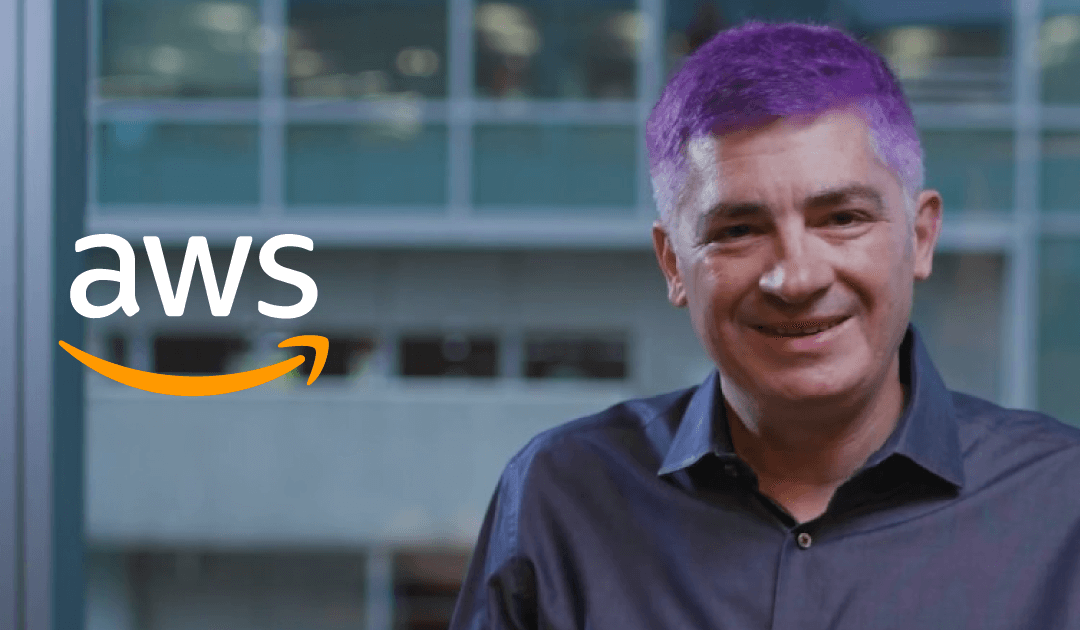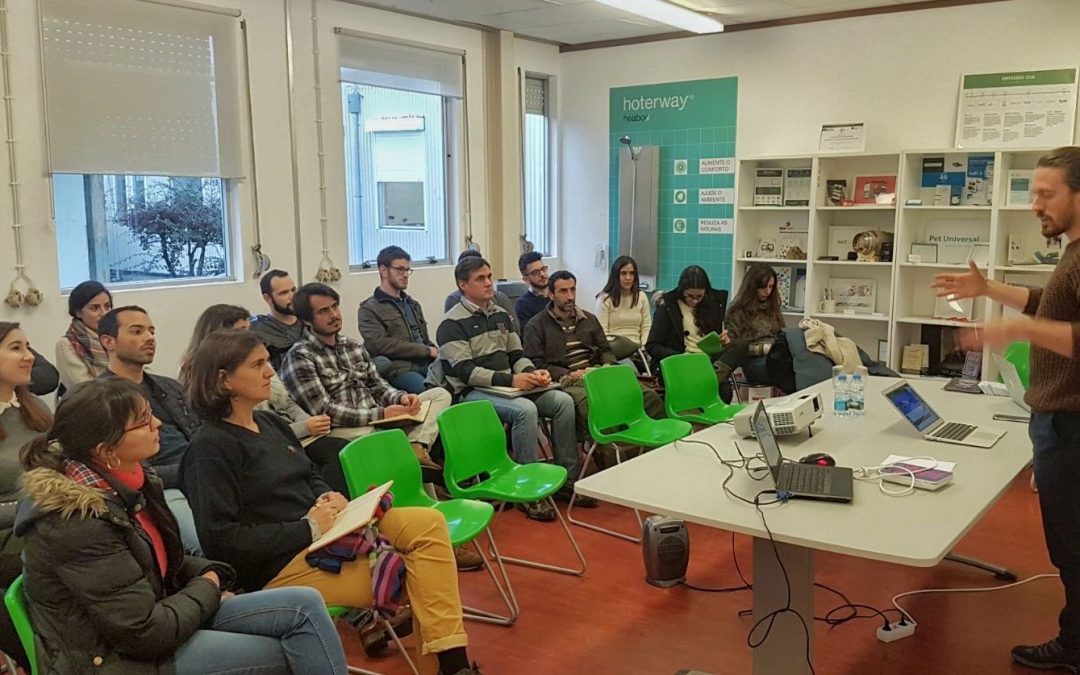
by Alisson Avila | Sep 18, 2019 | Corporates, Investors, Startups
Also AWS Chief Evangelist, he praised Feedzai and many other startups while sharing his vision on cloud computing
On September 11, we had the pleasure of hosting Jeff Barr, VP and Chief Evangelist from Amazon Web Services (AWS), at Beta-i headquarters. Our hub was the place for a special AWS Lisbon User Group talk led by Barr, and also open to our clients, about the major transformations of digital business brought about by cloud solutions.
This was an opportunity for Beta-i customers and the community to enjoy a moment of knowledge exchange and interaction with one of the leading corporate names in the digital economy, right at the moment that AWS invests in Portugal through a support office and a new Amazon CloudFront location. Owner of a very active blog, Barr gave this exclusive interview to Beta-i via email as he continued his ongoing worldwide sessions.
Your talk here in Lisbon summarizes the “double shift” of digital transformation provided by cloud computing: “from simply centralized computing and storage, operated on an on-demand, pay-as-you-go basis, to the industry-wide locus of innovation, host to a multitude of services”. What is AWS’s vision and ambition to take the lead in this gigantic universe?
Our vision is always the same: focus on customers and innovate on their behalf. To date, AWS has millions of active customers every month and the reasons why customers are turning to AWS is because it has a lot more functionality, the largest and most vibrant community of customers and partners, the most proven operational and security expertise, and the business is innovating at a faster clip – especially in new areas such as Machine Learning and Artificial Intelligence, Internet of Things, and Serverless Computing.
That being said, there is another reason why customers are choosing AWS: customers have come to really appreciate that the AWS culture is really different. If a startup, enterprise, or government agency is going to partner with a cloud provider, it’s typically a long-term decision they’re making, and they really want to understand what’s unique about the culture, or the partner that they are choosing. As a matter of fact, 90% of what we build is driven by what customers tell us matters, and the other 10% are things we hear from customers where they may not articulate exactly what they want, but we try to read between the lines and invent on their behalf.
We’re also trying to build relationships and a business that lasts longer than all of us in this room. And you do that by doing right by customers over a long period of time. An example that ties this all together is a capability in our support function called AWS Trusted Advisor. We’ll look at customers’ utilization of our resources, and if they’re low or idle, we’ll reach out to them and say, maybe you don’t want to spend this money right now. Over the last couple of years, we’ve used AWS Trusted Advisor to tell customers how to spend less money with us, leading to hundreds of millions of dollars in savings for our customers every year.
In your experience, does physical proximity still increase the number of business leads and connections? For how long?
We look at physical proximity as a way for our teams to better help our customers and support them in their cloud journey. In fact, our decision to invest in Portugal last year by opening an AWS office in Lisbon is in direct response to our Portuguese customers’ requests and our determination to support them in an even better way. It also follows many years of supporting a growing customer base in the country with their cloud adoption. AWS counts some of Portugal’s fastest-growing and most well-known businesses as customers including, Energias de Portugal, Feedzai, Federação Portuguesa de Futebol, Globalvia, Grupo Impresa, Jumia, Lusiaves, Miniclip, Prodsmart, OutSystems, Unbabel, and Uniplaces, as well as Public Sector organisations such as the City of Cascais and the City of Porto. We have seen there is a real appetite from organisations across Portugal looking to get started with AWS in order to innovate, lower their IT costs, and grow their organisations around the world.
More recently on September 5, 2019, we continued our investment in the country by launching a new Amazon CloudFront location. This new Edge location will offer all organizations in the country faster content delivery and added cybersecurity protection. Located in Lisbon, the new Edge location brings the full suite of services provided by Amazon CloudFront, including integration with computing, networking, and security services like AWS Lambda@Edge, Amazon Route53, Amazon S3 Transfer Acceleration, AWS Shield, and AWS Web Application Firewall (WAF).
We look forward to fostering the country’s pioneering spirit alongside our customers and helping them accelerate their digital transformation and deliver innovative new products and services.
Is it possible to assess the first repercussions of AWS CloudFront Point of Presence (PoP) set up in Portugal, or is it still too early?
AWS is committed to investing in Portugal and similar to our office opening, the launch of the first Amazon CloudFront location in Portugal follows feedback of our customers, so reception is very positive. Adding this Amazon CloudFront Edge location will help Portuguese organizations achieve lower latency while delivering the same levels of security that they have come to expect from AWS Cloud, ultimately resulting in a better overall experience for their end-users.
How would you describe AWS’s relationship with startups today? Which preferred model does Amazon use to connect to new external solutions?
Startups in Portugal and around the globe turn to AWS so they can innovate faster. They can focus their highly valuable resources on developing and marketing applications that differentiate their business and transform customer experiences instead of the undifferentiated heavy lifting of managing infrastructure and data centres. Because startups can very quickly develop and roll out new applications, it means they can experiment and innovate more quickly and frequently and if an experiment fails, they can always de-provision those resources without risk.
You only need to look at the number of successful startups from Portugal, such as Miniclip, Feedzai, Unibabel, Uniplaces, and Prodsmart who have launched their businesses globally. These customers are using AWS to drive innovation, accelerate time to market, and expand their businesses. For many years AWS has been supporting the Portuguese startup and technology community by bringing programs like AWS Activate to the country. AWS Activate provides startups with the resources they need to get started on AWS – including up to $100,000 (USD) in credits, training, support, as well as contact with incubators, accelerators and venture capital firms, such as Beta-i. Tens of thousands of startups take advantage of these benefits each year. In 2018, more than $500 million in AWS credits were given to help startups accelerate their growth and development as they build their businesses.
Which startups / new projects have caught your attention recently, and why?
One particular startup in Portugal that caught my eye is Feedzai. Feedzai is a Lisbon-based startup that detects financial fraud at scale. The company uses real-time machine learning & artificial intelligence AWS’s services such as Amazon Sagemaker to analyze transactions data through deep historical and behavioural analysis to identify fraudulent payment transactions and minimize risk in the financial industry. With more than 5 billion dollars of transactions processed daily, Feedzai enables major financial institutions worldwide (such as Lloyd’s Bank) to fight fraud effectively.
Earlier this week I was in Barcelona and was able to spend time with several fast-growing startups including Letgo, an online marketplace. They have been using AWS for over four years to support their rapid growth. I was impressed by their microservices architecture, and their ability to make use of a very wide variety of AWS services, including Amazon SageMaker and other machine learning services. One thing that I find interesting about this and other startups in the area is that the AWS cloud helps them to address global markets, regardless of the physical location of the company.
AWS’s re/Start project is a welcome and win-win solution for people, the market, and AWS itself. Are there any concrete plans to bring this initiative to Portugal in the coming years?
Portugal is an important country for us and we will continue to grow our presence and programmes as we grow our customer base. We are strong believers in the power of education and do our best to support training and up-skilling for everyone, regardless of who they are or where they are.
Your career span from working in one of the first retail computer stores in the world to your current position at AWS, not to mention startups and other big corporates experiences. From your personal perspective, but without considering points such as “agility and simplicity in startups” or “budget and structure on corporates”, what were the differentiating features or culture that most seduced you along with these experiences?
I would have to say that it is the first Amazon Leadership Principle, Customer Obsession. I have always done my best to understand and meet the needs of my contacts and customers, and this principle resonated with me right away. Another Leadership Principle, Dive Deep, reinforces my desire to always know as much as I can about the topics and technologies that I write and speak about.

by silvia | Sep 19, 2018 | Startups, Uncategorized
You only have one chance to make a good first impression. We very quickly (in a matter of seconds!) access others in terms of trustworthiness, reliability and hostility. This thought can be very daunting when you’re meeting with possible partners or investors – the good news is that you have anywhere between 1 to 20 minutes to make the best first impression.
There are three areas where you should focus on – yourself, your business and your audience – to make a first and lasting good impression.
Put your best foot forward.
Investors are looking for talented individuals they can trust with their money, and they need to feel confident in your capabilities as well as your personality.
- Social Expressivity – These are the expressions that we, as humans, will notice in each other’s facial expression, so try to smile to create empathy and not convey hostility, and look in your interlocutor’s eyes as it helps to establish trust between you.
- Good posture – Bad posture might be construed as lack of confidence in yourself or the business, so make sure to straighten your spine and shoulders (in a relaxed way) and give them a firm handshake. You can also lean in towards your interlocutor to show that you are listening and your focus is on them.
- Look the part – If you want to impress upon your audience that you’re an expert at something you should look like you are. We know that looks don’t mean much as competencies go, but in this occasion your audience will have a short amount of time to decide how they feel about you, so your look will play a role in it. If you’re in a very meticulous business, you don’t want a shirt stain to give the impression that you are not detail-oriented.
- Clean communication – Practice your speech before you go and, if possible, test it with colleagues beforehand. Your discourse should be organised and clear, so your audience can follow it easily. Confusing sentences can make your investors go into a rabbit hole of questions that will stray you off the presentation of your ideas the way you wanted to convey them.
No one knows your business better than you.
Show that you know your product and business better than anyone else could.
- Know your numbers – You should know your business inside and out as well as the market and competition. If possible, know your numbers by heart, as this will show how involved and knowledgeable you are. If not possible, then include them in the presentation in a impactful and meaningful way.
- Show your reasoning – Don’t make bold statements without any backing up data. Always show your investors how did you came to that knowledge and help them be on the same page as you.
- Have answers – Try to anticipate what will be their questions and have answers ready that can be tailored for specific questions. Sometimes, your business or market may be too innovative and you might not have all the answers yet. In that case never lie – experienced investors will see right through it. It’s better to be honest – admit that you don’t have all the answers and show them what your company is doing to correct that.
- Show off your team – Let them know which problems did you encounter along the way and how did the team solve it, and show them that you are team with the right set of skills that works well together to solve problems.
Focus on your audience.
You want to impress your investors but the best way to do it is to make it all about them.
- Know them and their role – In the day of google and social media, there’s no excuse to not recognize your interlocutors upon first meeting. Do a quick research to get to know them and the projects they usually invest on. If they’re corporate, understand their role in the company. If possible, find some of their interests or hobbies that you can bring into conversation to create a good rapport.
- Build a conversation – Speak with them and not “at them”. If they direct the conversation towards a specific topic, make sure you show them that you listened and incorporate their concerns into your ideas.
- Express your gratitude – Be polite and thank them. After all, they took the time to listen to your ideas.
Easy, right? It seems like a lot of tiny details, and some of these things you might already do naturally or they might be something your mum once told you (they are very good at these, moms). The important thing is that you feel prepared and confident that you’re on the right track for a great first impression.
Speaking of being in the right track, to our newsletter for more tips, news and event details.

by Carolina Santos | Jan 10, 2018 | Startups
Beta-i’s having a national tour. Yes, like we were a rock band, the difference is we’re not singing, we’re seeking talent, and we are not listening to music, we’re listening to pitches. But still, we want startups to ask us for an encore everytime we threaten to leave.
The first stop of our tour was Aveiro thanks to IEUA – Incubadora de Empresas da Universidade de Aveiro in the name of Vera Reis, Cândida Cardoso and specially to Adriana Costa, Incubator Director who has always greeted us on the best way possible and has done an incredible work. We started with a workshop of “How to Pitch” given by Gualberto Pastor and was a good way to break the ice.
After that was the elevator pitch, a 30-second pitch that everyone was gladly happy to do. It is amazing the level of the startups we found there raging from the energy sector, to health and artificial intelligence like Scubic, ASHA or YouClap. All proof that Portugal is becoming a strong ecosystem in itself, it’s not just Lisbon, it’s the whole country.
It is important to say we also learnt from our attendees. Sure, we knew we would find good startups and people willing to work and do new things, but the truth is we ended up meeting this person who reminded us why we started doing what we do in the first place, we met the face of the true entrepreneur, this extremely talented boy that makes you believe that our country can make a difference because we are extremely gifted.
We hope we’ll cross paths with them in the near future and we hope to continue to meet new and exciting portuguese startups.

by holiveira | Oct 11, 2017 | Corporates
Startup culture has its own language. Many of the terms tossed around sounds like something out of a Sci-Fi movie, or an episode of ‘The Big Bang Theory’, at the very least…
In fact, hearing the language of startups is a lot like watching a foreigner that kind of speaks Spanish trying to have a go at Portuguese. Some words you almost recognize, others you get a sense of what they’re hinting at. But it really doesn’t amount to anything, if you’re looking for your native tongue.
The truth is, most of these terms have come to stay. So there’s really no use in trying to swim against the current and ignore them. The innovative businesses popping up every week, feed and bask in this new ‘lingo’, so, if you want to bring your organization closer to innovation and growth, you better start by understanding what promising startups are actually talking about.
So, to help you get started, here are some key jargon:
Incubator: A space for businesses to research, gestate, and grow before attempting to hit the market. Think about a species of animal that can stand as soon as it is born and then walk and jump 24 hours after. OK, so that is not the type of animal that belongs in an incubator. Incubators are good for seed stage companies, that really need more time and care. Incubators are often also coworking spaces.
Accelerator: An accelerator is much like an incubator, but with more access to resources, mentors, know-how, investors, and corporate connections. In an accelerator, a company might outgrow its natural pace, hence the ‘acceleration’. Accelerators are spaces that have the resources to help a startup fail and try again.
Pitch: A presentation in which a startup founder attempts to persuade an investor about the viability of their company. The presentation varies, based on the specific purpose of the pitch. Brief presentations in which an entrepreneur provides a 30 – 60-second overview of their idea, business model, and marketing strategy, with the purpose of attaining a followup audience with an investor are described as ‘elevator pitches’. Formal, detailed presentations utilizing power point type slide decks, with the specific objective of seeking investment from angel groups or VCs, are known as ‘investment pitches’, and usually, amount to 3 minutes.
Burn Rate: The rate at which a company spends net cash over a certain period, typically a month. Investors are not very keen in putting their money where the burn rate is excessive, apart from some few exceptions, like Uber. In simple words, its how fast startups are blowing the cash they got in the first place.
Seed Money: The first investments in a company by someone other than the founder. The term comes from planting a seed for the first time. This is the initial round of capital for start-up companies, typically provided by angel investors through preferred stock or convertible bond-type instruments.
Unicorn: A company that has magically been valued at over $1 billion (1 million millions). Curated fashion platform Farfetch, founded in Portugal, is one such example. It’s a steep road, but all startups dream of becoming Unicorns…
You are now ready to enter the world of startups. But tread lightly, it a chaotic space, constantly changing and evolving. If you need some guidance, Beta-i is always here to help you navigate the entrepreneurial ecosystem.

by dboonstra | Sep 27, 2016 | Uncategorized
This week I had the pleasure of attending Road2WebSummit, the run-up event that has been building momentum for Europe’s biggest Tech-Event.
Amongst the Hotshots, Politicians and Gold-Diggers (I’ll let you decide where I belong on that list), was Web Summit resident pitch-king, Jack Costigan, host of the “How to Pitch” Workshop.
Web Summit sees hundreds of startups come and go, they’ve seen the good, the bad and the ugly at their pitch competition, aptly named, PITCH (go figure…). So when Web Summit sent their man to show us the light, I thought this would be something worth sharing.
1. Know your Audience- Tailor your pitch
This is an important one because it informs the shape and tone of your pitch. Your audience may be looking to get different things out of the presentation, they may have different levels of knowledge, and, lets be honest, different levels of interest. You need make sure that you are giving them the information that they want.
Some examples of different audiences might be:
- Investors
- Media
- Startup Competitions
- Sales/Customer
2. Say it and say it early
You need to communicate exactly what you do as as early as you can. If people don’t understand early on, you run the risk of losing people’s attention and when the Q & A comes around first question being: “so what do you actually do?”
3. Keep it Simple
You probably know your company too well and your audience likely knows next to nothing. Your pitch needs to bridge this gap. If it’s a short pitch, Costigan recommends the pyramid technique. The pyramid technique breaks your pitch down into 3 key parts: Unique selling point, Industry and Technology. Each form a point on the pyramid and together they tell your story.
4. Keep slides to a minimum
Slides are important but too many of them and your audience could lose interest. Each slide should have a key message and together these should tell the story of your product and company. Costigan recommends a general rule of 6-12 with a minimal, well-designed appearance.
5. Pitch Q & A- Be prepared
This is not a surprising one but the Q & A separates a good pitch from a brilliant pitch. This is your chance to show you really know your industry and your product. You have likely been living your company for the last year so you should already be an expert- now you have to prepare yourself to show it. If there is something in your pitch that you are unsure of, its probably best to leave it out rather than risk being questioned on it later.
6. Finally, Practise Practise Practise
The most natural pitches are the ones most practised. Even Steve Jobs spent hours rehearing his speeches. Maybe you know the content but the best pitch will be the result of hours of practise and fine tuning.
So there you have it- you have all the pitch knowledge you need to be the next Elon Zuckergates- all you need now is, working product, huge invest, thousands of hours of hard work, a great team and more luck than Irish rabbit playing in a field of four leaf clovers.
Go out there and pitch your heart out!




